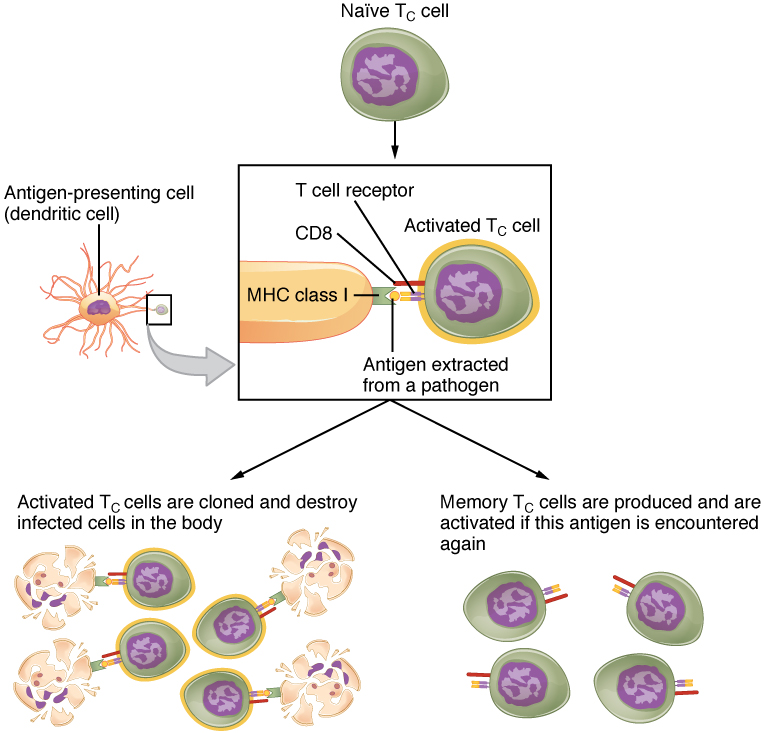What is the Difference Between Naive and Effector T Cells
Table of Contents
The key difference between naive and effector T Cells is that naive T cells are T cells that have differentiated but have not yet encountered their corresponding antigens, while effector T cells are T cells generated from naive T cells after they have encountered their corresponding antigens.
T cells are a major part of the immune system. They are the cells specifically designed to fight infection-causing agents they have not yet encountered. They differentiate in the thymus until released into the bloodstream as naive T cells. When a naive T cell encounters a recognizable APC (antigen-presenting cell), it converts to effector T cells such as cytotoxic T cells and helper T cells.
CONTENTS
1. Overview and Key Difference
2. What are Naive T Cells
3. What are Effector T Cells
4. Similarities – Naive and Effector T Cells
5. Naive vs Effector T Cells in Tabular Form
6. Summary – Naive vs Effector T Cells
What are Naive T Cells?
Naive T cells (Th0 cells) are T cells that have been differentiated and released by the thymus but have not yet encountered their corresponding antigens. A naive T cell is normally a T cell that has differentiated in the thymus and successfully undergone the positive and negative processes of central selection in the thymus. Among these native T cells, naive forms of helper T cells (CD4+) and cytotoxic T cells (CD8+) are included. Unlike activated T cells, a naive T cell is considered immature. Moreover, a naive T cell has not yet encountered its cognate antigen within the periphery.

Figure 01: Naive T Cells
Naive T cells respond to novel pathogens the immune system has not yet encountered. After a naive T cell recognizes its cognate antigen, it initiates the immune response. This results in the T cell acquiring an activated phenotype seen by the upregulation of surface markers such as CD25+, CD44+, CD62Llow, and CD69+. Furthermore, they may further differentiate into memory T cells as well.
What are Effector T Cells?
Effector T cells are T cells that are generated from naive T cells after they encounter their corresponding antigens. When naive T cells recognize an antigen, they receive three types of signals: an antigen signal through TCR or BCR, a co-stimulatory signal, and a cytokine signal. If a naive T cell receives all the above three signals, it differentiates into an effector cell. These effector T cell subsets include CD8+ T cells (killer cells), CD4+ T cells (helper cells), and regulatory T cells.

Figure 02: Effector T Cells
Cytotoxic T cells have the primary job of killing toxic target cells. Upon recognition, they remove virally infected cells, bacteria, and tumor fragments through a process called apoptosis. Activated helper T cells multiply and secrete cytokines that summon macrophages and cytotoxic T cells to the infection site. Furthermore, regulatory T cells are tasked with stopping an autoimmune response once the threat has been eliminated. Sometimes, some types of T lymphocytes are present even after removing a pathogen. These long-living T cells are known as memory T cells. These memory T cells are capable of responding to antigens upon reintroduction.
What are the Similarities Between Naive and Effector T Cells?
- Naive and effector T cells are two types of T cells in the immune system.
- Both are present in the bloodstream.
- They are differentiated T cells.
- Both of these closely work together to initiate immune responses to pathogens.
- Having adequate numbers of naive and effector T cells are essential for the immune system to respond to unfamiliar pathogens continuously.
What is the Difference Between Naive and Effector T Cells?
Naive T cells are T cells that have differentiated but have not yet encountered their corresponding antigens, while effector T cells are T cells generated from naive T cells after they have encountered their corresponding antigens. Thus, this is the key difference between naive and effector T cells. Furthermore, naive T cells are considered immature and inactivated, while effector T cells are considered mature and activated.
The below infographic presents the differences between naive and effector T cells in tabular form for side by side comparison.
Summary – Naive vs Effector T Cells
Naive and effector T cells are two types of T cells in the immune system that work closely together to initiate immune responses against pathogens. Naive T cells are T cells that are differentiated and have been released by the thymus but have not yet encountered their corresponding antigens, while effector T cells are T cells that are generated from naive T cells after they have encountered their corresponding antigens. So, this summarizes the difference between naive and effector T cells.
Reference:
1. “Effector T Cells – Cell Types – Knowledge Base.” PluriSelect USA.
2. “Naive T Cell.” An Overview | ScienceDirect Topics.
Image Courtesy:
1. “2218 Clonal Selection and Expansion of T Lymphocytes” By OpenStax College – Connexions Web site, Jun 19, 2013. (CC BY 3.0) via Commons Wikimedia
2. “General Effector Mechanisms of B and T Cells” By סתו כסלו – Own work (CC BY-SA 4.0) via Commons Wikimedia
ncG1vNJzZmivp6x7pbXFn5yrnZ6YsqOx07CcnqZemLyue9ahmK1lmah6tbTEZpuinpaav6a6wp5km52krLKmuoynmKKulWKur7CMnp2fnZOpvLN502aanqScqHw%3D